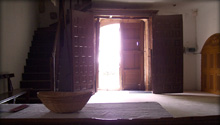 In our lives we are mostly directed by our eyesight. More than 80-85% of our perception is done through our eyes. If – with proper care and competence – we “switch off” this form of perception for a little while, we can experience ourselves and our world on a deeper level.
In our lives we are mostly directed by our eyesight. More than 80-85% of our perception is done through our eyes. If – with proper care and competence – we “switch off” this form of perception for a little while, we can experience ourselves and our world on a deeper level.
In our invisible theatrical performances our visitors are blindfolded and can experience more or less everyday situations, which, without the eyesight, can become cathartic experiences. Thus, this genre combines theatre, drama and play, and is also more than just a combination of these three. It is more because it introduces the visitor to the theatre, play and drama, as the spectator actually feels the happenings on their skin and experiences every detail of the story through their senses. The play becomes part of their life. Their life becomes part of the play. Everything happens to them. This theatre is a gate, entering which leads us inwards and upwards.
 The actors of the Invisible Theatre are the Ferrymen. They lead and help the spectators of the performance, the Wanderers. The Ferrymen lead the Wanderers according to a well elaborated conception and screenplay. When - after prior registration - the Wanderers arrive at the location, they are tuned onto the performance during a few minutes of silent waiting. Then they are called and blindfolded in the hallway of the Invisible Theatre, thus letting the performance begin. The story is dramatized in the stages, where the blindfolded Wanderer is lead, moved, helped and talked to by the Ferrymen, depending on the message of the given play. The lead and helped “spectators” walk along this way among scenarios drawn and built by their own imagination, while they are dramatizing the story with the help of their undisturbed senses.
The actors of the Invisible Theatre are the Ferrymen. They lead and help the spectators of the performance, the Wanderers. The Ferrymen lead the Wanderers according to a well elaborated conception and screenplay. When - after prior registration - the Wanderers arrive at the location, they are tuned onto the performance during a few minutes of silent waiting. Then they are called and blindfolded in the hallway of the Invisible Theatre, thus letting the performance begin. The story is dramatized in the stages, where the blindfolded Wanderer is lead, moved, helped and talked to by the Ferrymen, depending on the message of the given play. The lead and helped “spectators” walk along this way among scenarios drawn and built by their own imagination, while they are dramatizing the story with the help of their undisturbed senses.
After the performance, the so called Silent Room offers the Wanderers the possibility to silently meditate on what they have just experienced, and in the Presence Room they can also share their impressions with each other, helped by one of the Ferrymen.
The Wanderers can thus get an experience which is different from the traditional theatrical performance, and grows way beyond the involvement possibilities of the passive spectator of a traditional play. The “spectators” walk on their own invisible paths, and can get experience of something that – though invisible – leads them closer to their real selves than anything else.
The origins of the method
 The basic idea is the temporary elimination of the eyesight. This method appeared at the Lutheran Theology of Budapest as an alternative theatrical genre around 1999-2000. In its initial form it was invented by pastor Viktor Lénárt, who based this new genre on his previous experiences of psychodrama. The only other official amateur company of this genre is operating in Székesfehérvár. The Lutheran Campus Ministry lays special emphasis on securing that no one should be allowed to use the name Invisible Theatre without the thorough knowledge of the method. The only reason for this is the fact that the Ferrymen technique requires a high level of sensibility and attention, which can only be learned in a special training.
The basic idea is the temporary elimination of the eyesight. This method appeared at the Lutheran Theology of Budapest as an alternative theatrical genre around 1999-2000. In its initial form it was invented by pastor Viktor Lénárt, who based this new genre on his previous experiences of psychodrama. The only other official amateur company of this genre is operating in Székesfehérvár. The Lutheran Campus Ministry lays special emphasis on securing that no one should be allowed to use the name Invisible Theatre without the thorough knowledge of the method. The only reason for this is the fact that the Ferrymen technique requires a high level of sensibility and attention, which can only be learned in a special training.